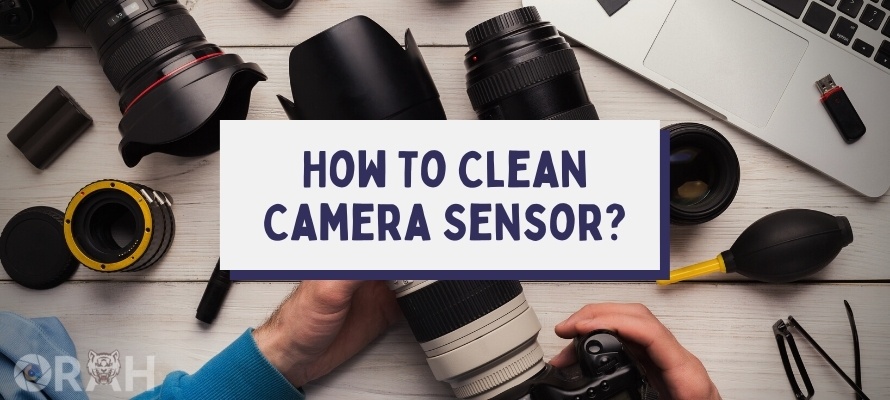
The sensor of any camera is more or less the heart of it or the mind if you want to use that terminology. Without a properly functioning sensor, you will not be able to take the photos you want to take or shoot videos.
Now, a lot of people are under the impression that it is okay to leave the sensor on its own, and while I do agree with it slightly, this is not entirely true.
You see, sensors can gather dust; this normally happens when you are shooting in dusty conditions, or you are shooting in such conditions which require you to change the lens of the camera time and again, and while doing so, small dust particles can find their way inside the sensor.
If you find yourself thinking about how to clean camera sensor, I am here to help you.
I normally advise to let the professionals do it, but there are some really good remedies that you can try on your own. Just be careful while attempting to do so.
What Is Sensor Dust?
For anyone who is wondering what sensor dust is, finding it out is not going to be a problem, to be honest. Any small particle that ends up on the sensor when it is exposed is called sensor dust.
This would be apparent in shots that have a lot of bright spots. Sometimes, tiny strands of hair are also considered sensor dust, so it is better that you are aware of this.
With that said, cleaning it is not difficult, to be honest. In most cases, photographers only start to clean their sensors when they know that the dust is severely affecting their photos, and the artifacts can be seen in the pictures.
This means that there is a high chance that their sensors already have particles of dust, but they are not that big of an issue as far as the cleaning process is concerned.
With that said, if your camera sensor does have dust on it, I am going to guide you on how to take care of it in the best way possible.
Related: How To Hold A Camera Like A Professional
How To Look For Sensor Dust
The annoying thing about sensor dust is that it is not always apparent right away. If you look at the sensor under a naked eye, you might not even spot it. That is how tiny some dust particles can be.
Thankfully, you can look for sensor dust by taking some pictures in a specific style, and I am going to guide you on how to do that.
First of all, you have to make sure that your camera’s focus is completely out of focus; this will be the only way the dust particles will be visible. Then take a picture of the sky, a white wall, or a white sheet of paper.
Once that is done, zoom in on the picture on either your camera’s screen or your computer screen and look for small particles; these are normally the black spots that you will find.
Also, make sure that your camera’s ISO is turned down to the minimum, the camera is on aperture priority mode, and both the autofocus and auto ISO are off. I would also suggest that you set your aperture to the maximum value just in case.
Once you have spotted the dust particles, the next step is that you clean the camera sensor. Now, camera sensors are extremely sensitive overall, wherein they can easily be scratched or destroyed if you are being careless, and I would not want that, either.
That is why I want to guide you on how to handle these things, so you do not have to stress about them. Your camera sensor can be cleaned with ease, and you will not have to go ahead and get it replaced, or the entire camera replaced, for that matter.
Why Is Cleaning Your Camera Sensor Important?
Now, you might find yourself wondering just why you need to clean your camera sensor in the first place. Why not just leave it the way it is.
Well, that is what most of us are going to do. Dust getting into a camera sensor is nothing new. But the impact of the dust particles on the pictures is what is more important.
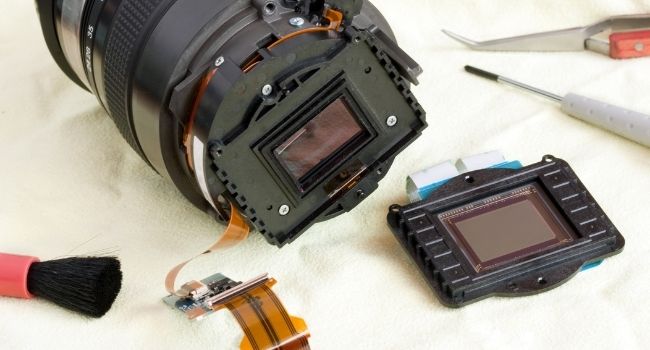
If the pictures, despite the dust, are clear as a day and there are no spots that you can see, then there is no point in cleaning the camera sensor.
Only when you start seeing visible stops in the pictures should be the time for you to start preparing the cleaning process.
The cleaning can be done on your own as there are sensor cleaning kits available, but if you are scared, as you should be.
Then it is better to take it to a professional, most of the time, they are not going to charge you anything, but this depends on how dirty the sensor is, to begin with.
What To Do Before Cleaning The Sensor?
If you are finally going to start the process of cleaning the sensor on your camera, it is better that you are doing it while being fully prepared.
You should never really do it in haste because it would not be good at all. The whole “haste makes waste” does apply here, and I would want everyone to be as careful as possible.
- The first thing you should do is have a clean table with nothing on it aside from the camera and tools to clean.
- I would also suggest that you turn off any ventilation or fans because you do not want a lot of dust particles flying around in the room.
- Make sure that your hands are as clean as possible, and if possible, cover your hair as well.
- Make sure that the surface that you are about to set the camera on is also dust-free, and all the tools are accessible right away. You do not want to leave the sensor exposed for too long.
I know this might sound overwhelming, but these are the steps that I follow every time I have to clean a camera sensor.
Related: How To Use A Light Meter – Enhance Your Photography!
How To Clean Your Camera Sensor?
Now that we are done talking about everything, you need to know about cleaning the sensor. The next step involves talking about the methods that can help you clean the sensor in the best way possible.
Let’s not delay and have a look, shall we?
1- Using The Auto Clean Function?
The first method that I am going to suggest to everyone is that you should try using the auto-clean function that is available on almost every modern camera, mirrorless or otherwise.
This is a great way of handling dust particles that do not adhere to the camera sensor.
If you are wondering how this works, the auto cleaning method shakes the sensor for a few seconds, just enough that the dust particles fall off the sensor.
This feature is turned on by default in many cameras, but you can go to the settings and find this feature as well, and it will work just perfectly, and that too, without any issues.
2- How To Wet Clean Your DSLR Sensor?
This one is for the sensor dust that is old and has adhered itself to the sensor, as it can be difficult to remove by just using a simple auto-clean function.
This also happens to be one of the most technical ways of cleaning the sensor, and unless you have watched enough tutorials and you know what you are doing, I would advise against it.
If it is a DSLR, you will have to go to the settings and put the camera in the manual cleaning mode. For mirrorless, you can simply turn the camera off and remove the lens to access the sensor.
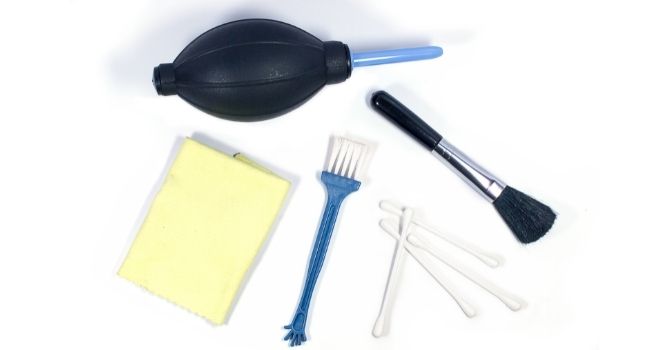
Now that you have read the disclaimer let’s get started. You are going to need the wet cleaning liquid along with the swabs. These do ship with the cleaning kit, so you do not have to worry about sourcing these from elsewhere.
Getting down to the cleaning process, remember, once you have opened the sensor, I would suggest putting the cleaning liquid onto the swab and giving the sensor a gentle sweep with the wet side.
Remember, you are only to do it once and then use one for a dry sweep as well. Just to make sure that there are no streaks left on the sensor.
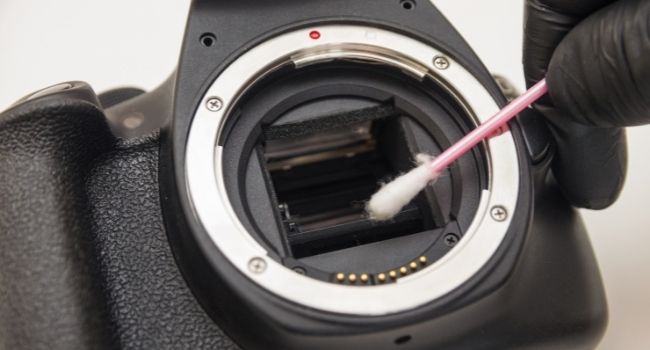
I understand that this feels scary. Thankfully, there are enough tutorials available for you to check out if you are feeling overwhelmed, you can see how it is done on the video, and that should calm down the nerves to some extent, and you would not have to worry as much.
3- Cleaning With A Rocket Blower?
Another safe method of cleaning your sensor and getting rid of any dust is using a small rocket blower that you can buy. Usually, these come with sensor cleaning kits, so you do not have to stress much about it, to begin with.

To do that, put your camera in the manual cleaning mode if it is a DSLR. For mirrorless, the sensor would be exposed once you remove the lens.
With that said, hold the camera upside down and use the rocket blower to blow some air at it. This should get rid of any dust particles and make them fall.
Remember, you should take breaks between the blows because you want to be certain that the dust particles have had enough time to fall out and down from the sensor.
Once that is done, you can put the lens back on and try a few shots using the methods above to see if there is any dust.
4- By Using A Sensor Stamp Or Pen?
The last thing that I am going to suggest to you is a sensor stamp or a pen that you can use to clean the sensor. These are also handy tools that people have been using for some time to clean the sensors and to be honest, they work just fine.
You just have to be sure that you are doing it properly, and there are no complications in the way because we want to avoid it in the best possible way.
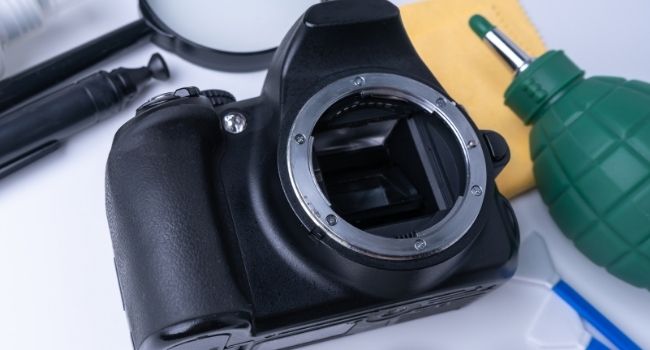
You can look at the tutorials available on YouTube but using a sensor stamp, or a pen is also one of the easier ways once you get a hold of it.
Just be sure that the pen or the stamp is not exposed to any other dust from outside the sensor because it will only become a bigger nuisance in terms of the cleaning process, and we do not want that for anyone.
Rest assured, the methods that I have mentioned in the article should help you clean the sensor with ease. If you are still feeling overwhelmed or confused, you can always get a professional to do it for you.
Best Practices For Keeping Your Sensor Clean
I am now done talking about the cleaning process. Therefore, it would only make sense if I start talking about how you are going to be able to keep the sensor clean in the first place.
That way, you would not have to send your camera to someone for cleaning or clean the sensor frequently.
The tips that are mentioned below should help anyone get through the cleaning process with ease, and it is honestly not even that difficult.
- The first tip that I am going to suggest to you is that you should avoid touching your camera sensor at all costs. No reason in the world would require you to touch the sensor as it is simply not going to be good for it, and it is better if you are avoiding it.
- Secondly, you would only be able to spot the sensor dust if it is there. This means that there is no need in the world to check your sensor for dust even when you know that there is no dust present in the first place.
- Lastly, when changing lenses, be careful about the whole process, if you have a mirrorless camera, then there is a higher chance of the dust getting inside. So, avoid being in ridiculously dusty situations and changing lenses amidst those situations, as that is not going to do good for you at all.
Suggested readings:
- How to photograph the moon
- How to photograph lightning
- How to update your camera firmware
- How to power cycle Wyze camera
- How to set up your camera
- How to take a 3d photo
- How to make a video a live photo
- How to photograph your own eye
Wrap-Up:
I understand that sensor cleaning is a tough one for a lot of people, and most people get terrified at the thought of that, but the best thing is that you will not have any problems once you get it done the right way.
The process is not that difficult, and you will be done without any problems. Just be sure that you are cleaning the sensor the right way, and you are going to be all good in no time.
Frequently Asked Questions (FAQs)
Q1- Is it safe to clean the camera sensor?
Answer: Yes, it is completely safe to clean the camera sensor. But just be sure that you are following all the directions available to you, and you are not doing anything that would otherwise harm the sensor as that would only put you at the risk of damaging the sensor entirely.
Q2- Can I use alcohol to clean the camera sensor?
Answer: A lot of people would suggest that you should use cleaning alcohol to clean the camera sensor, but I am going to advise against that as alcohol cleans properties that can muck up the sensor, and if that happens, things become even more difficult to clean.
Q3- Can I clean my camera sensor with a QTIP?
Answer: I know a lot of people who have tried to clean the camera sensor with a QTip, and it never really resulted in anything good.
Q-Tips, despite being soft, can easily damage your camera, and it would be better if you are avoiding that all together since a replacement sensor is going to cost you a lot of money.
Q4- Can I clean the camera sensor with a microfiber cloth?
Answer: Sure, a microfiber cloth might make sense to a lot of people, but I would never advise you to touch the sensor with that.
A clean, wet swab is what I would suggest everyone use if it ever comes to touching the camera sensor. Everything else is a red flag, and it is not to be done.
Q5- Can I use lens cleaner on my camera sensor?
Answer: Not, a lens cleaner is more or less used for just cleaning the glass. Putting the same solution on your camera sensor can cause harm that cannot be compensated for at all.
Therefore, if you want to clean the sensor using a solution, use the camera cleaning kit that comes with swaps for your camera sensor.
Q6- What is a sensor cleaning solution?
Answer: A sensor cleaning solution is a liquid that is used to clean the sensor. However, you are not supposed to use this solution on its own.
You are to apply it on a swab and then use that swab to wipe the dust off the sensor. Then you are to use another swab, but a dry one this time to remove any residue that may have been left on the sensor.
Q7- How do I know if my camera sensor needs cleaning?
Answer: You will be able to see small black spots in your images, especially in the brighter areas of the photo that do not have any other objects.